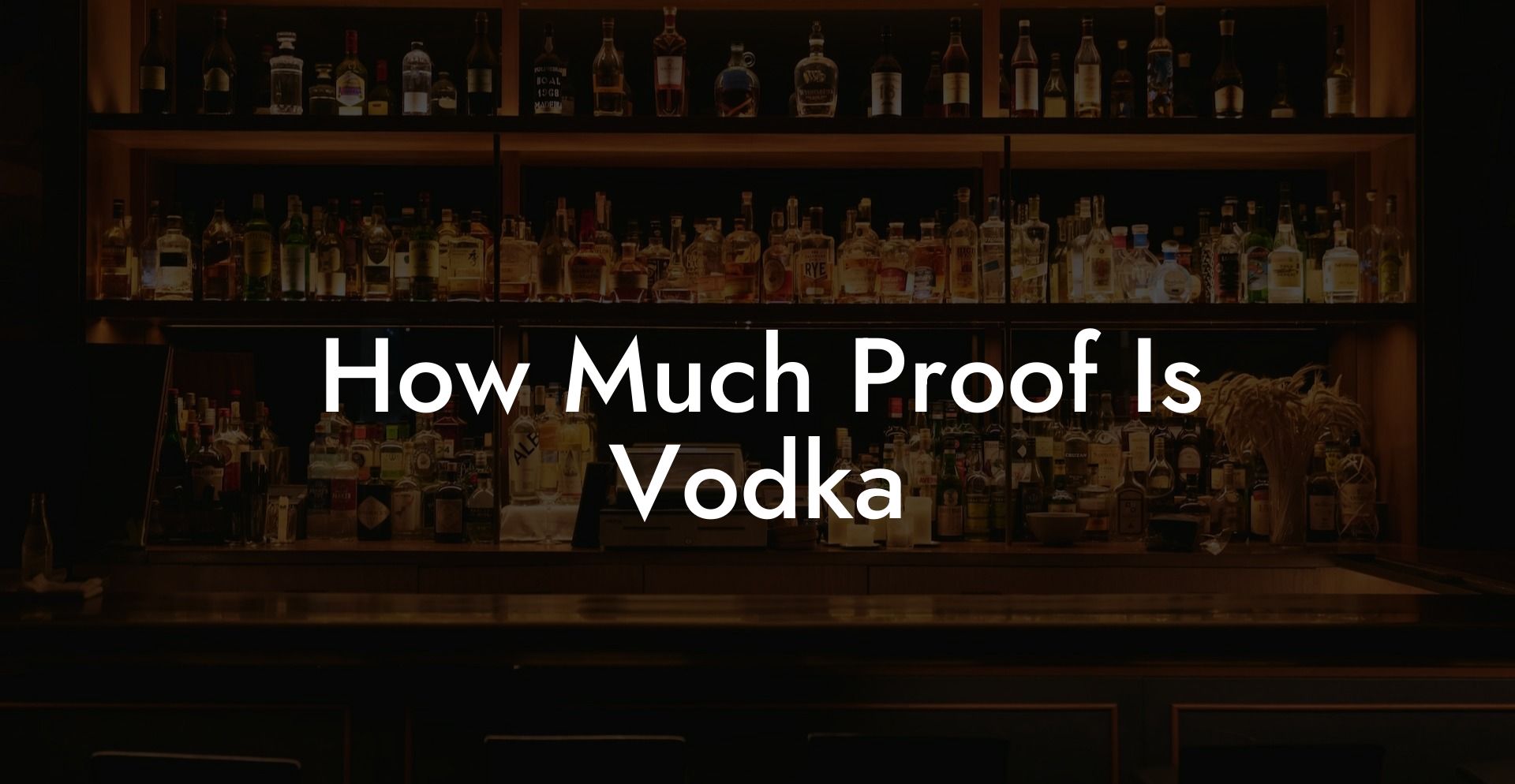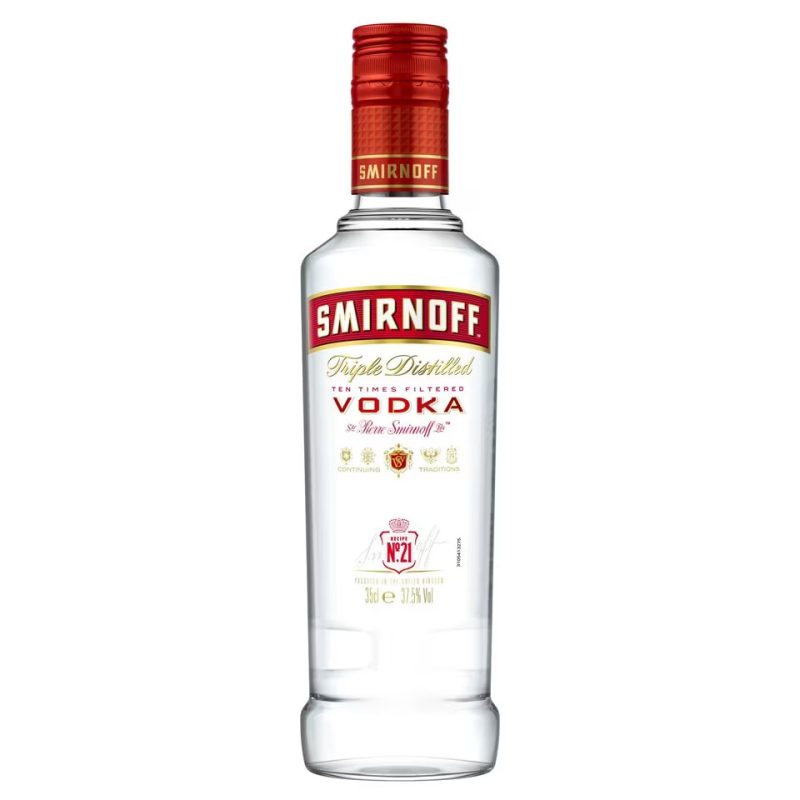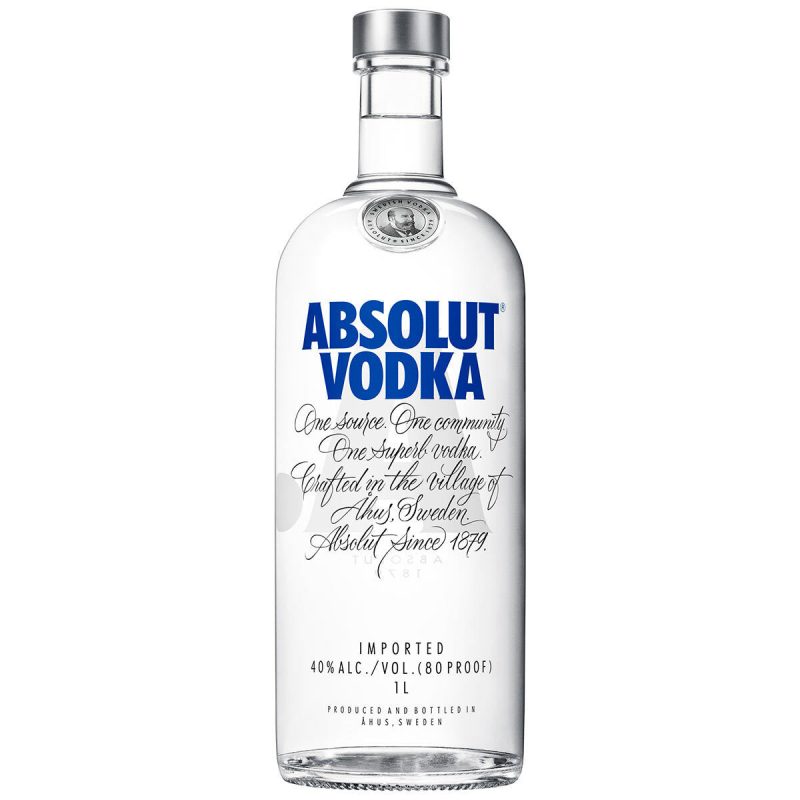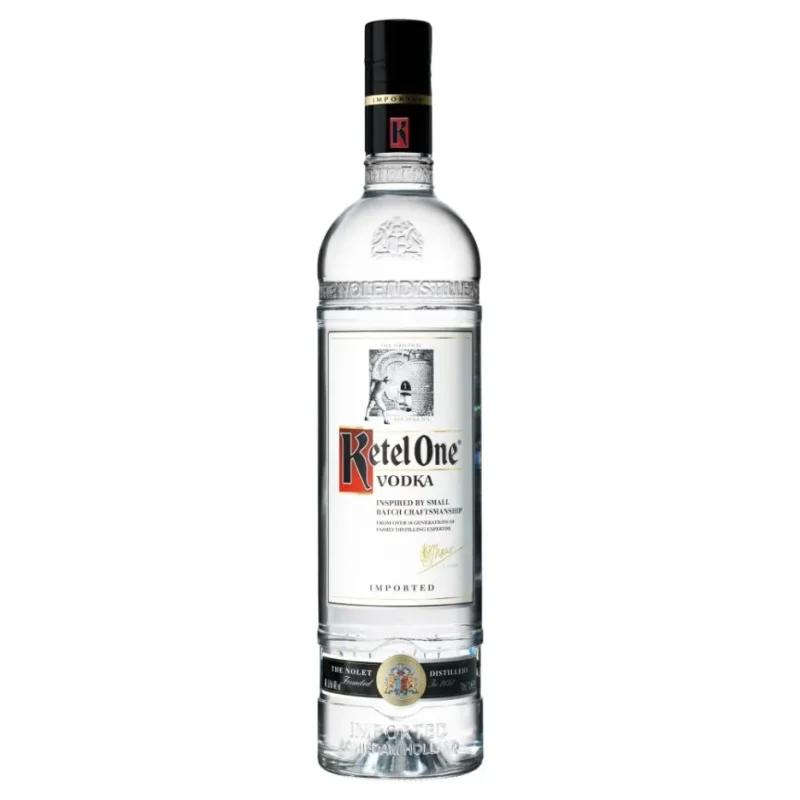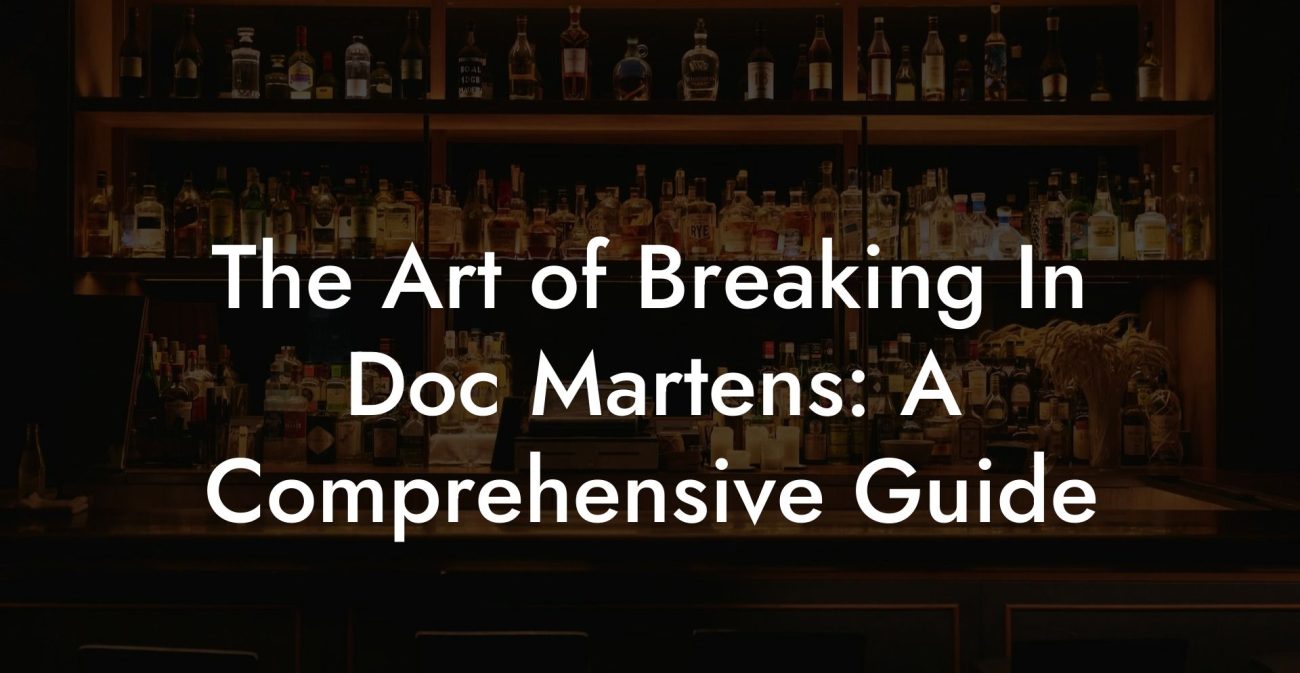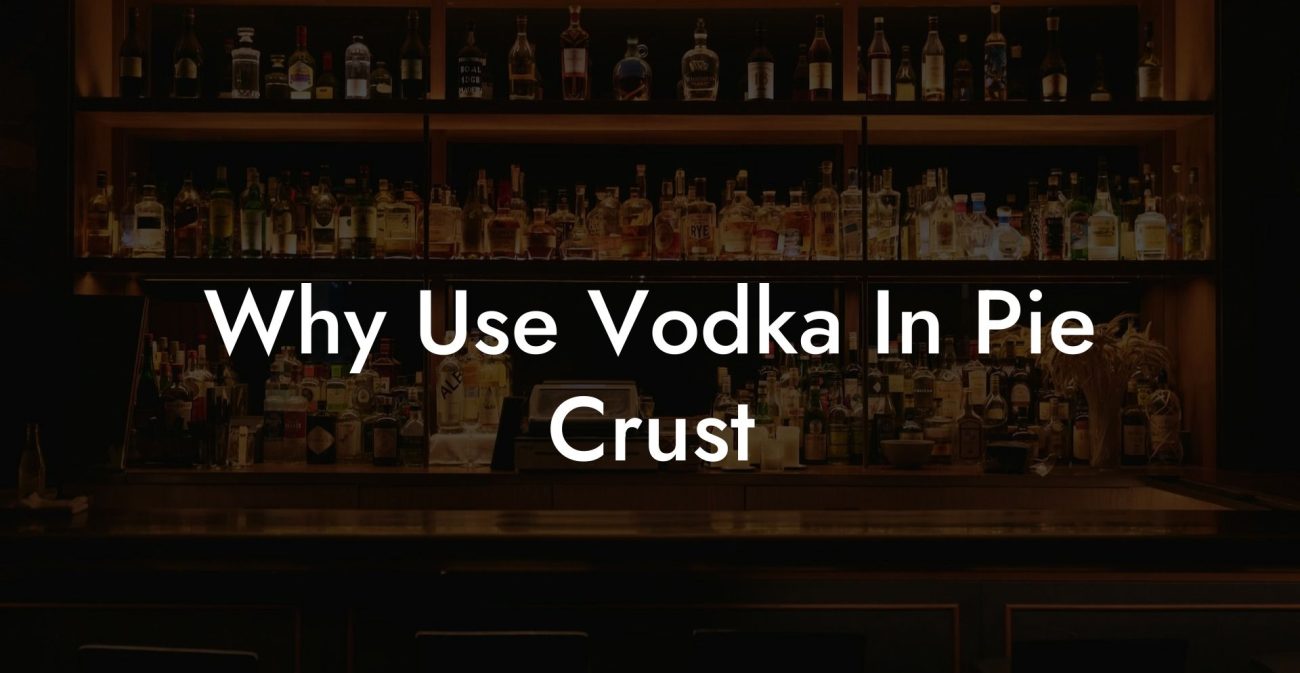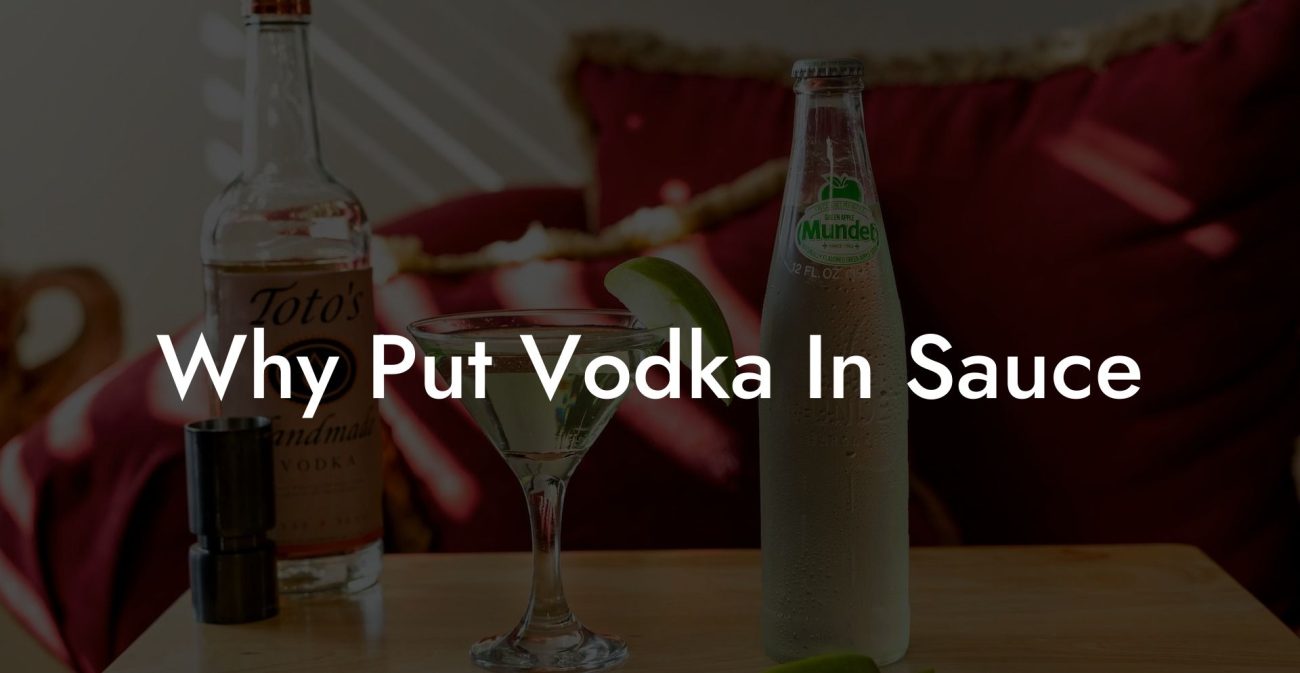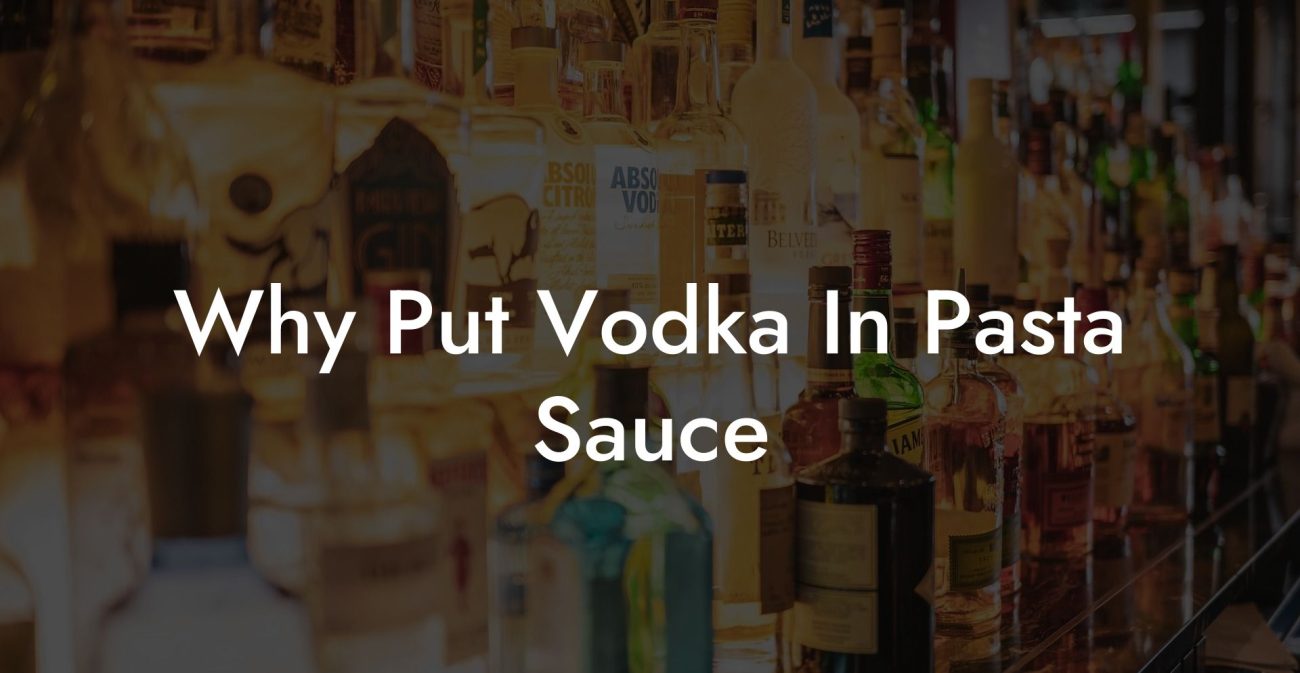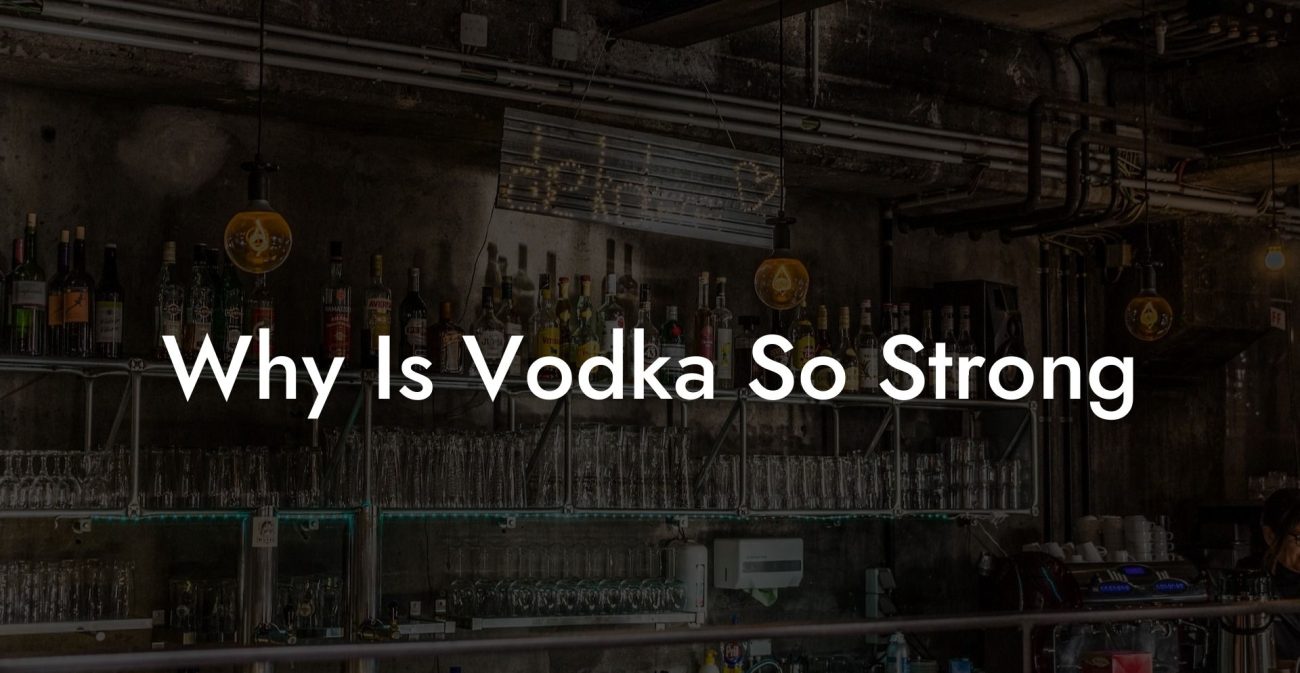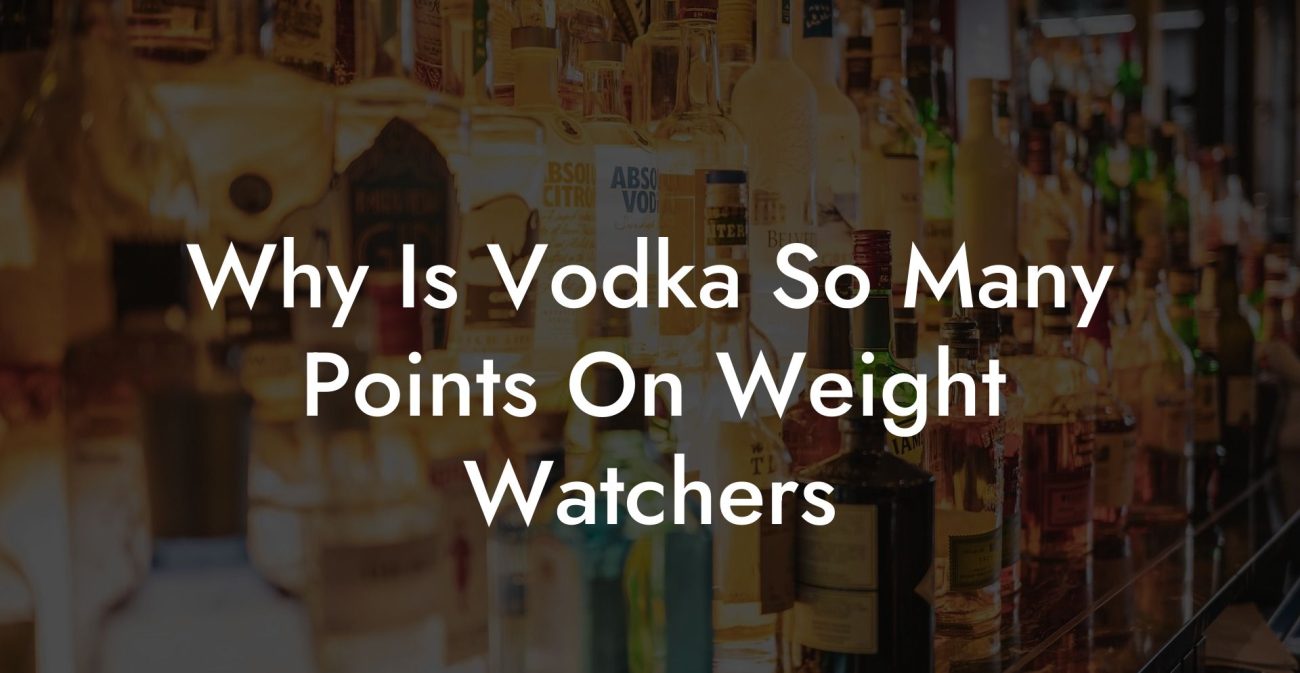Ever found yourself at a party, glass in hand, wondering, “How much proof is this vodka, really?” If you’ve ever squinted at a bottle’s label or dived deep into spirited online debates about whether overproof vodka turns your cocktail into a fire-breathing beast, you're not alone. Welcome to our ultimate guide on vodka proof—a no-nonsense, irreverent, and refreshingly honest deep-dive designed just for you curious millennials and Gen Z aficionados.
How Much Proof Is Vodka Table of Contents
The History Behind Vodka Proof: From Fiery Experiments to Modern Mixology
Common Vodka Proof Levels and What They Mean for Taste and Mixability
The Science of Vodka: Complexity in Simplicity
Mixology Magic: How Vodka Proof Impacts Your Favorite Cocktails
Vodka Proof and the Culture of Today: What Millennials and Gen Z Are Loving
Factors to Consider When Choosing Your Vodka Proof
Myths and Misconceptions About Vodka Proof
Vodka Around the World: A Global Perspective on Proof
Resources and Community Support: Your Next Steps
DIY Vodka Cocktail Recipes: Experiment and Have Fun
Dispelling the Intimidation Factor: Vodka Proof Made Simple
Vodka Proof: A Gateway to Exploration and Creativity
FAQs About Vodka Proof: Your Essential Questions Answered
Your Journey to Vodka Enlightenment Starts Now
Looking For The Best Vodka? You'll Love These Vodka Guides...
What Exactly Is Vodka Proof?
At its core, vodka proof isn’t a secret code meant to confuse you; it’s simply a number that tells you how potent the spirit is. Think of it as the “spicy factor” in your favorite hot sauce, but for alcohol. The term “proof” dates back to a time when bartenders would test alcohol strength by setting it on fire—if it lit up, it was “proven” to be strong enough. Nowadays, we measure it more scientifically, but the name stuck.
In the United States, the proof of an alcoholic beverage is exactly twice its alcohol by volume (ABV). So, if a vodka bottle boasts 40% ABV, it’s labeled as 80 proof. In other parts of the world, they rely solely on ABV percentages, but here in the States, proof is our way of adding a bit of flair to plain numbers.
Whether you enjoy sipping your vodka neat, mixing it into a killer cocktail, or just using it as an excuse to taste-test, understanding vodka proof can transform your drink experience and up your cocktail game.
The History Behind Vodka Proof: From Fiery Experiments to Modern Mixology
The term “proof” originated in 16th-century England, when sailors and tax collectors needed a quick way to gauge the strength of liquors. One popular method was to douse gunpowder with the spirit; if it ignited, the liquor was deemed “proof” of its high alcohol content. This rather dramatic test gave birth to the term and set the stage for centuries of spirited (pun intended) experimentation.
Fast forward to today, and while we no longer light vodka on fire (safely, at least), the concept of “proof” still plays a crucial role in demystifying your liquor cabinet. Vodka, with its storied past and intriguing production methods, has evolved into a canvas for mixologists worldwide, offering varying levels of proof to suit every taste.
Best Budget Vodkas Ranked
From the ultra-smooth 80 proof vodkas that are perfect for a laid-back evening to the high-octane, overproof spirits that pack a punch in a daring cocktail, the evolution of vodka proof reflects changing tastes, technological advances, and even cultural shifts in how we appreciate our drinks.
How Is Vodka Proof Measured?
If you’re wondering, “How do they even check the proof of vodka?” here’s the lowdown: modern distilleries use a combination of scientific precision and quality control that’s leagues ahead of those rudimentary gunpowder tests.
The most common method involves using an alcoholometer—a specialized hydrometer designed to measure the density of a liquid relative to water. Since ethanol (alcohol) is less dense than water, the reading on an alcoholometer can reveal the exact ABV. Multiplying this value by two gives you the proof in the United States. For example, a vodka with 50% ABV is 100 proof.
Advanced labs may even use gas chromatography, ensuring that vodka not only meets safety standards but also delivers the flavor and consistency expected by discerning drinkers. This scientific rigor not only guarantees quality but allows brands to experiment with new proof levels and flavor profiles, catering to the ever-evolving tastes of today’s market.
Common Vodka Proof Levels and What They Mean for Taste and Mixability
Vodka proof levels can vary considerably, and knowing what these numbers imply helps you choose the right spirit for your drink or direct sip. Here are some common categories:
- 80 Proof Vodka (40% ABV): The classic choice that forms the backbone of most cocktail bars. Its balanced potency makes it versatile for mixed drinks and serves as a smooth base in vodka tonics, martinis, or even a simple vodka soda.
- 90–100 Proof Vodka (45–50% ABV): For those who like their cocktails a bit more robust, higher-proof vodkas offer enhanced flavor intensity and a warming sensation that can elevate simpler drinks. Perfect for those evenings when your social media feed demands something extra bold.
- Overproof Vodka (110+ Proof): The daredevils of the vodka world. These spirits are not for the faint-hearted—they’re meant to be used sparingly in cocktails to add a kick or even flambéed at events to impress your friends.
The beauty of vodka lies in its ability to adapt. A well-crafted 80 proof vodka might serve as a blank canvas for delicate botanicals in a cocktail, while a higher-proof option can hold its own against robust flavors. The choice depends entirely on your taste preference and how you plan to enjoy it.
The Science of Vodka: Complexity in Simplicity
Vodka is often described as “neutral,” but don’t let that trick you. Behind its seemingly bland exterior lies a complex interplay of distillation techniques, filtration methods, and subtle flavor nuances that can vary widely from one brand to another.
Distillers experiment with different grains, potatoes, or even grapes to create a unique flavor profile. The art of vodka making revolves around removing impurities while retaining enough character to keep things interesting. As a result, the proof level isn’t just a number—it’s a reflection of centuries-old traditions combined with modern-day innovation.
Whether you’re a purist who prefers sipping vodka neat or an adventurer who loves exploring craft cocktails, the proof of your vodka influences not only its strength but also its mouthfeel and aftertaste. So next time you pick up a bottle, remember: there’s science—and a dash of art—in every shot.
Mixology Magic: How Vodka Proof Impacts Your Favorite Cocktails
Ever mixed a cocktail only to have it taste bland or overly potent? The secret might be lying in your vodka proof. Mixologists have long known that the balance of flavors in a cocktail depends heavily on the alcohol proof used.
Lower-proof vodkas, like the standard 80 proof, tend to blend seamlessly with mixers, offering a smooth backdrop for a variety of flavors without overwhelming them. They’re ideal for long drinks, like a refreshing Moscow Mule or a bright, citrusy vodka lemonade.
On the other hand, higher-proof vodkas are perfect for creating bold, unforgettable cocktails. That extra punch helps the spirit’s flavor shine through, even when mixed with strong mixers or bitters. Ever tried an overproof vodka in a spicy Bloody Mary or a daring cocktail that calls for a dramatic finish? The intensity is real—and it’s a game changer for those cocktail connoisseurs looking to make a statement.
Ultimately, the choice of proof isn't just a technicality; it's a creative decision that can transform an average drink into a memorable experience. Next time you're at home experimenting with mixology, consider how different proof levels can tweak your drink's overall profile.
Vodka Proof and the Culture of Today: What Millennials and Gen Z Are Loving
There’s no denying it—vodka has become something of a cultural icon, and its vibrant versatility appeals to a young, adventurous crowd. Whether you're attending a glitzy rooftop party, hosting a cozy get-together, or binge-watching your favorite series on a chill night in, the proof of your vodka is more than just a number; it’s part of the experience.
Millennials and Gen Z have a penchant for authenticity and innovation, which is why many brands are playing with the concept of overproof and infused vodkas. They’re not just offering a drink; they’re selling a lifestyle. Think limited-edition releases, Instagram-worthy packaging, and artisanal production methods that highlight everything from sustainable ingredients to unique flavor infusions.
Social media challenges, meme culture, and influencer collaborations have all helped boost vodka’s status as a trendy, must-have spirit. Whether it’s crafting the perfect cocktail for your next TikTok video or debating the ideal mix for your Insta story, the conversation around vodka proof is interwoven with modern pop culture.
And let’s not forget the resurgence of homemade cocktail culture. With an abundance of online tutorials, recipe blogs, and mixing apps, young drinkers are taking a hands-on approach to crafting their own signature drinks, often experimenting with different vodka proofs to nail that perfect balance of flavor and potency.
Factors to Consider When Choosing Your Vodka Proof
Selecting the right vodka for your next celebration isn’t as simple as just picking your favorite label off the shelf. Here are a few key factors to consider when choosing the right proof:
- Occasion: Are you planning a casual night with friends or a sophisticated cocktail party? Lower-proof vodkas work well for everyday mixing, while higher-proof options might be reserved for those special, attention-grabbing moments.
- Cocktail Recipe: The desired cocktail flavor profile can dictate your choice. Lighter, more refreshing drinks generally benefit from an 80 proof base, whereas complex cocktail recipes that call for intense flavor notes might shine with a 100 proof or higher vodka.
- Taste Preference: Some people enjoy the smooth, mellow sway of a classic vodka, while others prefer the robust kick of an overproof spirit. Tasting at home or sampling different brands (responsibly, of course) can help you find your personal match.
- Budget: Price points can vary dramatically, and while higher-proof vodkas may offer a unique flavor experience, standard proof vodkas often provide great quality for a more reasonable cost.
- Mixability: Consider how the vodka will interact with other ingredients. If your goal is to let the flavor of a particularly aromatic mixer shine through, the proof of your vodka can make a world of difference.
Armed with these considerations, you can confidently navigate the vodka aisle and choose a spirit that not only meets your tastebuds' demands but also enhances your drink-making adventures.
Myths and Misconceptions About Vodka Proof
Let’s bust some myths. One common misconception is that higher proof always equals better quality. Not true! Vodka proof is about strength, not flavor quality. A lower proof vodka can be smoother or more balanced, while a higher-proof variant might pack heat but sometimes at the expense of subtlety.
Another myth is that you can “outeffect” a high-proof vodka with mixers alone. While it's true that mixers can dilute the kick, the potency of the alcohol remains, meaning responsible consumption is key regardless of the mixer’s volume.
And then there’s the old wives’ tale that if a vodka is 100 proof or higher, it will literally set things on fire. While overproof vodkas are flammable and can be used in flambé displays, this isn’t a regular party trick—safe handling and proper knowledge are essential.
Dispelling these myths empowers you to choose vodka based on what genuinely enhances your experience rather than succumbing to flashy numbers or outdated lore.
Vodka Around the World: A Global Perspective on Proof
Vodka isn’t confined to one corner of the globe—its journey has taken it from the cold steppes of Russia to the bustling urban bars of New York City. And interestingly, different regions have their own twist on what proof means.
In many European countries, the focus remains on the alcohol by volume (ABV) rather than using the proof system. This approach provides a straightforward percentage reading that appeals to those who prefer simplicity in numbers. Regardless, the quality, flavor, and versatility of vodka remain a top priority worldwide.
International vodkas might experiment with unique production methods, regional ingredients, or innovative infusion techniques, but the core idea remains the same: to create a spirit that’s both reliable and exciting. For the global citizen who loves a good cocktail as much as they love traveling, understanding these regional differences can add a whole new layer of appreciation to your spirited adventures.
Resources and Community Support: Your Next Steps
Ready to jump deeper into the world of vodka proof? Whether you’re a curious newbie or a seasoned enthusiast, the community is buzzing with resources and support to help you navigate your journey.
Start by checking out online forums and social media groups dedicated to craft spirits. Platforms like Reddit, Instagram, and TikTok are full of enthusiasts sharing cocktail recipes, distillery tours, tasting notes, and even hold live Q&A sessions with master distillers.
Additionally, consider visiting local distilleries or attending tasting events where you can experience different proof levels firsthand. Many cities now offer immersive experiences that allow you to learn all about the nuances of vodka, from how it’s made to the art of mixing the perfect drink.
Finally, don’t be shy about reaching out to experts. Bloggers, podcasters, and mixologists are often eager to share their knowledge and can offer personalized recommendations based on your tastes and preferences.
Embrace the journey, and remember: discovering the perfect vodka is just as much about the community and experiences you gather along the way as it is about the proof on the label.
DIY Vodka Cocktail Recipes: Experiment and Have Fun
Now that you're armed with all the juicy details about vodka proof, it’s time to put that knowledge to the test. Here are a few original cocktail recipes that highlight how different proof levels can transform your drink:
The Easygoing Classic
Ingredients: 2 oz 80 proof vodka, 4 oz soda water, a squeeze of fresh lime, ice.
Instructions: Fill a tall glass with ice, add the vodka, splash in the soda water, and finish with a generous squeeze of lime. Stir gently and enjoy a refreshingly balanced drink.
The Bold Awakener
Ingredients: 1.5 oz overproof vodka (110+ proof), 1 oz fresh grapefruit juice, 0.5 oz simple syrup, a dash of bitters, ice.
Instructions: Combine all ingredients in a shaker with plenty of ice. Shake vigorously, strain into a chilled coupe glass, and garnish with a slice of grapefruit. This potent drink is sure to wake up your taste buds!
The Social Media Star
Ingredients: 1.5 oz 90 proof vodka, 1 oz elderflower liqueur, 2 oz cranberry juice, 1 oz club soda, fresh mint leaves, ice.
Instructions: Muddle a few mint leaves in your shaker, then add vodka, elderflower liqueur, cranberry juice, and ice. Shake well, strain into a fancy glass, top with club soda, and garnish with an extra sprig of mint. Get ready to snap that perfect Instagram boomerang!
Experiment with these recipes and tweak them based on your favorite proof levels. Whether you lean towards the smooth classic or crave the fiery intensity of an overproof concoction, there’s no limit to what you can create.
Dispelling the Intimidation Factor: Vodka Proof Made Simple
We know that diving into the details of vodka proof can seem overwhelming at first. But here's the good news: the numbers don't have to be intimidating. Think of proof as a friendly nudge that tells you how strong your drink will be, so you can plan your evening accordingly.
Whether you're experimenting with your first cocktail recipe or refining a signature drink for your next house party, understanding vodka proof is all about empowering you to create the drink experience you want. Embrace the process, trust your taste buds, and remember that even a miscalculated cocktail can lead to a hilarious story and a great memory.
In a world that often feels complicated, let the simplicity of vodka proof remind you that sometimes, the best moments are found in the small details—a perfectly balanced cocktail and good friends to share it with.
Vodka Proof: A Gateway to Exploration and Creativity
Behind every bottle of vodka lies the potential for discovery. From understanding your drink’s potency to exploring innovative recipes, vodka proof invites you to experiment and push the boundaries of your mixology skills.
This isn’t just about alcohol—it’s about creativity, culture, and connecting with a community that appreciates the art of a well-made drink. The numbers on the bottle are just a starting point; your imagination is what turns a simple spirit into a masterpiece.
So next time you uncork a bottle of vodka, take a moment to think about the story behind that proof. What does it say about the craftsmanship, the tradition, and the innovation that went into its making? Let that curiosity guide you as you explore new cocktail recipes, discover hidden gem distilleries, and share your experiences with fellow enthusiasts.
FAQs About Vodka Proof: Your Essential Questions Answered
Here are some frequently asked questions that get to the heart of vodka proof—serving up practical answers with a side of humor.
1. What does “proof” mean on a vodka bottle?
In the United States, the proof is simply the alcohol by volume (ABV) multiplied by two. So, a vodka with 40% ABV is 80 proof.
2. Why is vodka proof important?
Vodka proof gives you an immediate sense of how potent your drink is, which helps you manage your mixology and consumption habits effectively.
3. Can I mix high-proof vodka with other ingredients?
Absolutely! High-proof vodkas are great for cocktails that require an extra punch, but they work best when paired with ingredients that can balance the intensity.
4. Is higher proof always better?
Not necessarily. Higher proof means a stronger kick, which can be great for certain cocktails, but a lower proof might be preferred for a smoother, more balanced flavor.
5. How is the proof measured?
Modern methods use an alcoholometer or more advanced techniques like gas chromatography to accurately determine the alcohol content.
6. What proof is best for beginners?
Beginners might enjoy starting with an 80 proof vodka (40% ABV) because of its versatility for various mixtures and ease on the palate.
7. Can vodka proof affect the taste of my cocktail?
Yes, the proof plays a major role in the cocktail's overall flavor profile. A higher proof can bring forward more intense flavors and a pronounced alcohol bite, while a lower proof tends to blend more harmoniously with mixers.
8. Are there any health concerns associated with high-proof vodka?
As with any alcoholic beverage, moderation is key. High-proof spirits should be consumed responsibly to avoid any unwanted side effects like impaired judgment or overindulgence.
Your Journey to Vodka Enlightenment Starts Now
From understanding the number behind the label to crafting the perfect cocktail, vodka proof isn’t just a technical detail—it’s an invitation to explore a world where science meets art, and tradition dances with innovation. Whether you’re the life of the party or the quiet curator of your own intimate tasting sessions, there’s always something new to learn and enjoy about this timeless spirit.
Embrace the journey with curiosity, share your favorite recipes, and join the vibrant community that’s reshaping what it means to enjoy vodka in the modern age. Remember, every bottle has a story, every sip is a discovery, and every cocktail is an experiment waiting to happen.
So next time you lift that glass, let the number on it—be it 80, 100, or even overproof—spark your imagination. Celebrate the artistry of vodka, the ingenuity behind its creation, and the endless ways you can make it your own.
Cheers to making informed choices, delightful discoveries, and a future where every shot, sip, and cocktail tells a story of flavor, fun, and fearless exploration. Your journey to vodka enlightenment starts now—dive in, experiment, and above all, enjoy every drop.

